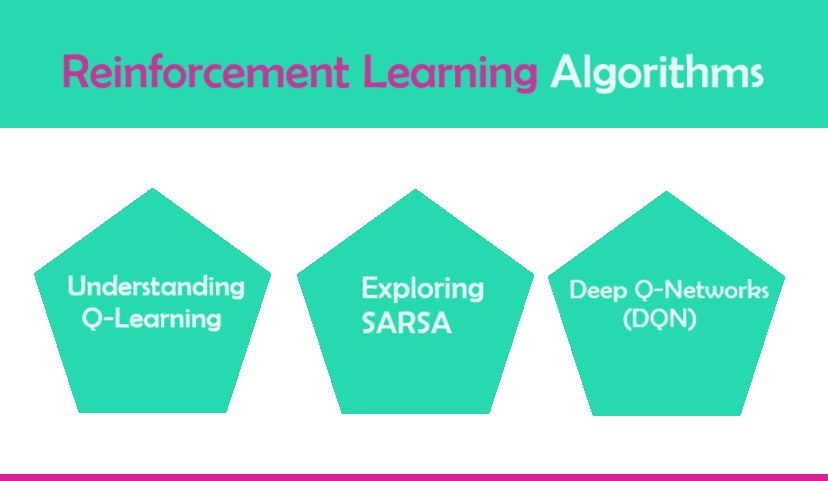Introduction
Reinforcement learning is a subfield of machine learning that focuses on training agents to make decisions in an environment to maximize rewards. One of the key challenges in reinforcement learning is finding the optimal policy for an agent to follow. In this article, we will explore three popular reinforcement learning algorithms: Q-Learning, SARSA, and Deep Q-Networks (DQN).
Understanding Q-Learning
Q-Learning is a model-free reinforcement learning algorithm that learns an optimal action-value function, known as Q-values, for each state-action pair in the environment. The Q-values represent the expected cumulative reward an agent will receive by taking a particular action in a given state. The algorithm iteratively updates the Q-values based on the Bellman equation until convergence.
Example:
Consider a simple grid world where an agent must navigate from a starting point to a goal while avoiding obstacles. At each state, the agent has several possible actions (move up, down, left, or right). Q-Learning enables the agent to learn the optimal action-value function, guiding it towards the goal while maximizing cumulative rewards.
Here’s a simple example to illustrate how Q-Learning works:
state = initial_state
while not done:
action = select_action(state)
next_state, reward, done = environment.step(action)
Q[state, action] = Q[state, action] + learning_rate * (reward + discount_factor * max(Q[next_state, :]) - Q[state, action])
state = next_stateExploring SARSA
SARSA is another model-free reinforcement learning algorithm that is similar to Q-Learning. However, SARSA is an on-policy algorithm, meaning that it updates its Q-values based on the current policy it is following. The name SARSA stands for “state-action-reward-state-action,” which represents the sequence of states, actions, rewards, and next states that the agent encounters during training.
Example:
Continuing with our grid world scenario, SARSA learns by interacting with the environment. At each step, the agent selects an action based on its policy, observes the reward and next state, and updates its Q-values accordingly. This on-policy nature makes SARSA well-suited for scenarios where the agent must continuously adapt its behavior, such as in real-time strategy games.
Here’s an example of how SARSA works:
state = initial_state
action = select_action(state)
while not done:
next_state, reward, done = environment.step(action)
next_action = select_action(next_state)
Q[state, action] = Q[state, action] + learning_rate * (reward + discount_factor * Q[next_state, next_action] - Q[state, action])
state = next_state
action = next_actionDeep Q-Networks (DQN)
Deep Q-Networks (DQN) is a reinforcement learning algorithm that uses a neural network, known as a Q-network, to approximate the Q-values. DQN combines the power of deep learning with reinforcement learning, allowing it to handle high-dimensional state spaces. The Q-network takes the current state as input and outputs the Q-values for all possible actions.
Example:
Imagine training an AI to play Atari games using DQN. The neural network takes raw pixel values as input and outputs Q-values for each possible action. Through experience replay and target networks, DQN addresses instability issues inherent in training neural networks with RL. This enables the AI to learn effective strategies for a diverse range of games, surpassing human performance in many cases.
Here’s an example of how DQN works:
state = initial_state
while not done:
action = select_action(state)
next_state, reward, done = environment.step(action)
replay_buffer.add(state, action, reward, next_state, done)
batch = replay_buffer.sample_batch()
Q_targets = reward + discount_factor * max(Q_target_network.predict(next_state))
Q_values = Q_network.predict(state)
Q_values[action] = Q_targets
Q_network.update(state, Q_values)
state = next_stateApplications and Future Directions of Reinforcement Learning Algorithms: Q-Learning, SARSA, and Deep Q-Networks
Reinforcement learning algorithms find applications across various domains, including robotics, autonomous vehicles, finance, and healthcare. As research continues to advance, the integration of RL with other techniques, such as meta-learning and imitation learning, holds promise for tackling increasingly complex tasks.
Applications
1. Robotics: Reinforcement learning enables robots to learn tasks like grasping objects and navigating cluttered spaces autonomously.
2. Autonomous Vehicles: RL algorithms help vehicles learn safe driving policies, optimizing decision-making processes like lane-keeping and merging.
3. Game Playing: RL is used in games, teaching agents to play chess, Go, and video games like Atari games.
4. Finance: RL aids in algorithmic trading, portfolio management, and risk assessment, optimizing investment decisions.
5. Healthcare: RL optimizes treatment plans, personalized treatment recommendations, and resource allocation in hospitals.
6. Recommendation Systems: RL enhances recommendation systems in e-commerce, streaming platforms, and social media, improving user engagement.
Future Directions:
1. Multi-Agent Systems: Research focuses on collaborative and adversarial scenarios, enabling agents to coordinate and compete effectively.
2. Transfer Learning: Developing efficient transfer learning algorithms to facilitate knowledge transfer across domains.
3. Safety and Ethics: Ensuring safe exploration and ethical behavior of RL agents, mitigating negative side effects.
4. Hierarchical RL: Developing algorithms to discover and exploit hierarchical structures in tasks.
5. Neuroscience and Cognitive Science: Drawing inspiration from biological learning mechanisms to design more efficient algorithms.
6. Real-World Deployment: Addressing scalability, robustness, and interpretability challenges for deploying RL in real-world applications.
By advancing research in these areas, reinforcement learning can continue to revolutionize various fields, addressing real-world challenges and unlocking new capabilities.
Conclusion
Q-Learning, SARSA, and Deep Q-Networks are three popular reinforcement learning algorithms that have been widely used in various applications. Q-Learning is a simple and efficient algorithm that learns the optimal policy by updating Q-values. SARSA is an on-policy algorithm that updates its Q-values based on the current policy. DQN combines deep learning with reinforcement learning to handle high-dimensional state spaces. Each algorithm has its strengths and weaknesses, and the choice of algorithm depends on the specific problem at hand. By understanding these algorithms, researchers and practitioners can apply them to solve complex reinforcement learning problems.

